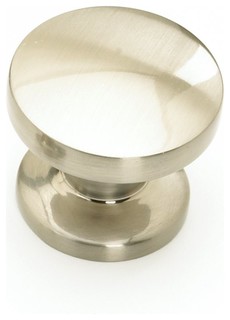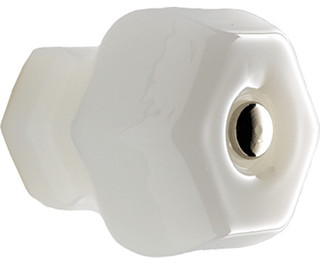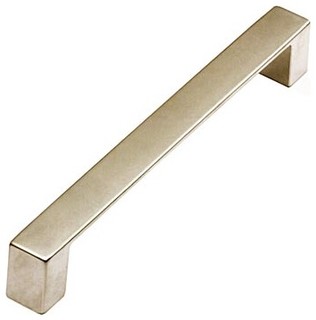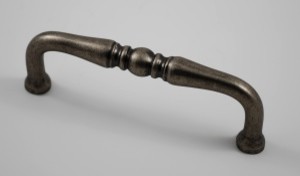8 Top Hardware Styles for Shaker Kitchen Cabinets
 Friday, August 23, 2013 at 10:04AM
Friday, August 23, 2013 at 10:04AM Article By: Rebekah Zaveloff
Shaker-style cabinet doors are so flexible stylewise that they can go either traditional or modern depending on what you pair them with. Decorative elements like lighting, tile and hardware can really change the tone and overall style of a kitchen. Cabinet hardware is often referred to as the jewelry of a kitchen, and just like with an outfit, it can really alter the overall look of your space.
1. Traditional Nickel or Steel Knobs and Bin Pulls
Shaker cabinets are known for their simple, clean lines, and often you'll see them paired with simple, unadorned cabinet hardware. Whether your style is vintage or modern, you'll find that a Shaker door is one of the most versatile doors styles available. A vintage-style kitchen with white Shaker cabinets is often seen finished with a combination of timeless cup or bin pulls and knobs.
Traditionally you'll see knobs on doors and bin pulls on drawers. For drawers 30 inches and wider, two bin pulls are often used.
What they do for the kitchen: Add retro flair.
What they work well with: Inset cabinetry with exposed hinges, stainless steel, white marble and honed black countertops, industrial-style lighting.
On vintage bin pulls, the face screws are functional; on reproductions the face screws may be faux, with the pull attached through the back.
2. Vintage Glass or Ceramic Knobs
Vintage-style glass, also referred to as Depression Era glass, is another classic hardware choice for Shaker cabinets. With a stained cabinet finish, it's nice to create some contrast with the hardware by using a white glass knob.
Putting knobs on drawers is a great vintage touch, though pulls are more user friendly for everyday use.
This type of knob comes with and without a face screw, as well as in a variety of colors, transparent and opaque, as well as clear.
What they do for the kitchen: Create a historical feel that can go Victorian, Arts and Crafts or colonial revival.
What they work well with: Glass-front hutch cabinets, stained wood cabinets, butler's pantry or scullery-style cabinets, subway tile, black and white kitchens.
3. Vintage Pulls With Exposed Screws
This type of hardware is reminiscent of vintage double-hung window hardware and can add a great vintage or industrial touch to a new kitchen. It looks completely different in a nickel finish than in oil-rubbed bronze or antique brass.
What they do for the kitchen: Add a utilitarian and industrial feel.
A traditional-style kitchen with Shaker cabinets gets a modern touch with nickel or stainless steel tubular bar pulls. This type of hardware is often seen on slab or flat-panel doors, but it works equally well on a Shaker-style door. Tubular bar pulls can be long and dramatic or short and classic.
What they do for the kitchen: Modernize it
In this kitchen, the hardware's accentuated length and polished nickel finish add a little modern glamour. In the same way a font choice affects the look of a logo, the decorative hardware of a kitchen can transform the overall experience of the space.
What they do for the kitchen: Add a contemporary edge.
What they work well with: White or dark Shaker cabinets, square-edged stone or concrete countertops, full-height glass backsplashes, oversize rectangular tile in a stacked pattern
6. Accented Wire Pulls
This kitchen leans more traditional, with tall crown molding, a decorative hood surround and a bronze faucet, but the cabinet doors are still classic Shaker.
What they do for the kitchen: Allow you to add more decorative moldings and traditional elements.
7. Arced and Footed Bar Pulls
For a more classic look, there are arced and footed pulls. These go by many different names and can also fall into the wire-pull category. These pulls are traditional and just decorative enough without being too fussy for a Shaker door. Mixing finishes on dark and light cabinets helps to create contrast on each and keeps the kitchen from feeling stale.
What they do for the kitchen: Add a more traditional and decorative element.
What they work well with: Stone mosaic tile backsplashes, nickel diamond-mesh cabinet inserts, marble countertops with a decorative ogee edge.
Go Ahead: Mix Your Finishes
When people say all white kitchens look alike, I can't disagree more. Just changing the finish of the hardware completely changes the look of a kitchen, even when the hardware is exactly the same style.
Depending on the other finishes in your kitchen, you may consider satin nickel, polished chrome or nickel, or oil-rubbed bronze. Don't feel like you have to match the cabinet hardware to the lighting or plumbing fixture finishes. I like to mix finishes by using antique brass light fixtures and polished nickel pulls to give a kitchen a more collected-over-time feel.
When using two or more cabinet finishes, as with the stained island and white perimeter cabinets shown in this kitchen, it's perfectly fine to mix up the finishes of the hardware as well! Not everything has to match — the nickel finish wouldn't look as good on the stained island as the antique bronze finish does, for example.
 Cabinet Hardware,
Cabinet Hardware,  Hardware in
Hardware in  Decorate & Design,
Decorate & Design,  Kitchen
Kitchen 






































